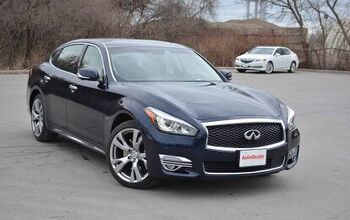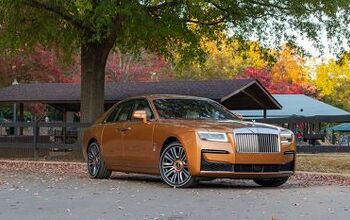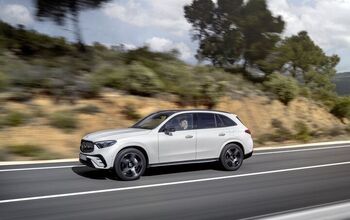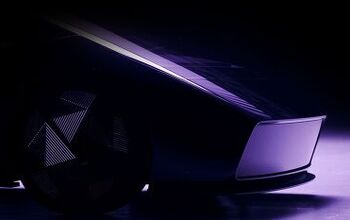2015 Infiniti Q70 Review

Despite its strongest efforts, Infiniti has generally played second or third fiddle to the usual suspects when it comes to premium car brands, but the last few new products – the three-row QX60 crossover and Q50 sport sedan – are making even the most jaded critics take notice.
FAST FACTS
| Engine: 3.7L V6 makes 330 hp, 270 lb-ft in base models; hybrid models use a 3.5L V6 with 50-kw electric motor for 360 hp while the 5.6L V8 makes 420 hp and 417 lb-ft in regular Q70, but loses a few hp in stretched L model. |
| Transmission: Seven-speed automatic. |
| Fuel economy (city/highway): 3.7 RWD: 18/26 MPG. Hybrid: 29/34 MPG. 5.6 RWD: 16/24 MPG city/highway. |
| Price: Q70 3.7 starts at $50,750, Q70 Hybrid is $56,800, while loaded Q70L 5.6L is $65,450. |
Despite getting new names a couple years back, there have been few subsequent alterations to the rest of Infiniti’s products.
Finally, there are some signs of life because the mid-size Q70 is being refreshed for 2015. The car now gets the same corporate Infiniti grille that debuted on the Q50 and is now slowly moving through its siblings. The lower fascia is different; with brighter chrome trim bits around the lower air intake and fog lights. The headlights also now get the company’s signature LED-accented headlights. The rear end gets similarly subtle updates, including different rear lights and a slightly reshaped bumper.
Now Longer Than Before
But the biggest news – har, har – is the new extended-wheelbase L model. Amazingly, the L looks really well balanced and it takes a good eye to spot one without its smaller twin alongside.
Already built for the Chinese market where models with prodigious rear seat space are king, the Q70L sees a 5.9-inch stretch in wheelbase and 7.2-inch increase from bumper to bumper. The wheelbase figure is directly applicable to rear knee room, which increases the to 32.5 inches with a similar 5.6-inch boost in overall rear legroom.
Beyond the business class cabin, extended wheelbase models get brighter reading lamps and a spare 12-volt power outlet in the back along with available heated rear seats and doors that can’t be slammed to prevent passengers from being caught if their chauffeur is too zealous about shutting them.
There are quibbles, though. While Infiniti provides three seatbelts, the middle rider will end up perching uncomfortably on the large driveshaft tunnel. It would also be nice to have the option for cooled rear seats because the aftmost air vents alone aren’t adequate to chill the area on intensely sunny days.
Otherwise, the rest of the Q70’s interior is largely unchanged, with 10-way power heated front seats, a heated steering wheel and beautiful ash trim all standard. As are a 10-speaker Bose audio system with a USB port, navigation, Bluetooth connectivity and satellite radio. The seven-inch touch screen is easy to read and is where the around-view monitor and rear-view cameras display.
Specs Stay Mostly The Same
Mechanically, the Q70 remains largely the same. Most models use Infiniti’s 3.7-liter V6 with 330 horsepower and 270 lb-ft of torque, while the optional 5.6-liter V8 with makes 420 horses and 417 lb-ft (or 416 horsepower and 414 lb-ft in Q70Ls because of a rerouted exhaust.) Both engines can be had in either wheelbase, with seven-speed automatic transmission and either rear- or optional all-wheel drive.
The Q70 Hybrid retains its 3.5-liter V6 and 50-kw electric motor that combine to 360 horsepower, although it’s only available in the regular wheelbase in rear-wheel drive configuration.
Infiniti is also offering optional sport packages, although only in short-wheelbase models; Q70L models can get a 20-inch wheel package with more enthusiastic rubber, but nothing more dramatic.
Sport Models Noticeably Better
The difference on the road between the V6 Sport I drove and the more relaxed Q70L with the same engine is pretty remarkable. The Sport package adds beefier brakes with four-piston front calipers and two-piston rears and firmer springs with “double-piston” dampers, which also helps better control the five-spoke 20-inch wheels with rubber-band 245/40R20 performance tires.
The Sport’s ride isn’t unpleasant and I made decent progress on the curvier, tighter roads through the verdant hills in New Jersey. Most of the alterations from normal to Sport are well done, although a couple things are lacking.
First, the big V6 can be heard in the cabin quite clearly and whether that’s a good thing or bad depends entirely on your feelings about the VQ V6 family, but the point is that sound deadening could be better in thecar. My driving partner found it unrefined; I found it entirely acceptable and refreshing in this era of whooshing turbos and synthesized exhaust notes.
Second, the Sport’s steering is sub-par and fails at delivering road feedback through the wheel. Like most other new cars, Infiniti uses an electrically assisted steering pump to save fuel, but it still hasn’t nailed the algorithm on weight and feedback. It is too light and there’s too little information translating to the rim.
The recent Q50 faced the same criticism and apparently its Sports models will “sport” old-school hydraulic power assistance borrowed from the old G37, sometime in 2015. It would probably be too difficult to easily adapt for the Q70 since it’s too far along in its life.
Splendid Interior Quality
The seats are supposedly unique with better side bolstering, but felt too wide and unsupportive over long distances. It’s the only model with paddles to better control the seven-speed automatic and since they’re magnesium, they are much nicer to touch than the plastic-fantastics in some rival machines.
With nine distinct models – two wheelbases, three engines, two drive options – and up to eight optional equipment packages to choose from, that old phrase “there’s something for everyone” really does ring true. To go through absolutely everything here would be a waste, but a few highlights are worth mentioning.
The technology package ($3,300) includes Infiniti’s full suite of safety technologies including active lane departure, forward collision warning with brake assist, full-speed-range intelligent active cruise control and active backup collision intervention, which will apply the brakes if it senses an oncoming car while you’re reversing out of a parking spot. And the Deluxe Touring package ($3,900) adds things like a larger eight-inch touch-screen, a 16-speaker audio system, power-rear sunshade, nicer leather trim and softer materials spread throughout most of the cabin.
Q70 prices start around $51,000 with destination included, with V8s starting about $12,000 higher. All-wheel drive adds about $1,500 per model, as does stretching the wheelbase.
The Verdict
Overall, Infiniti’s efforts – however small – are welcome and the Q70L is an interesting prospect, mainly because it’s in a class by itself. Other manufacturers offer extended wheelbase models, but they are generally versions of already massive products – i.e. Audi A8, BMW 7 Series, Lexus LS, Mercedes-Benz S-Class and Porsche Panamera. But Infiniti doesn’t have a “true” flagship sedan anymore, so the long Q70 will have to keep customers sated or they’ll continue to head elsewhere.
LOVE IT
- Beautifully integrated stretch
- Unique position with few true competitors
- No small turbo-four here!
LEAVE IT
- Steering needs retune to add confidence
- Fuel mileage in all but Hybrid
- Cabin getting dated

Mark has worked as an automotive journalist for over 10 years, starting as a student at Centennial College, in Toronto, by launching an auto-review section in the college paper, The Courier. Since then, he's been Editor of Inside Track Motorsport News and its Streetwise section of new-vehicle reviews and industry news, done stints at Carguide and World of Wheels, and currently works as an award-winning freelancer for AutoGuide.com, MSN Autos Canada and more. He's also a first-time father, so don't be surprised if the frustration of properly installing a car seat creeps into his work.
More by Mark Atkinson































Comments
Join the conversation
Sounds like a dud, although the longer wheelbase sure makes it look better.
Infiniti need a true flagship. I hope that new Q90 or whatever it's called will be it.